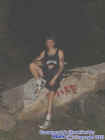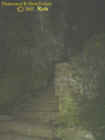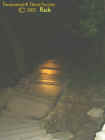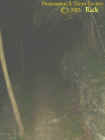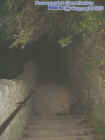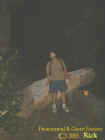|
|
||
|
Devils Hole runs along the Niagara gorge and today is a state park roughly 43 acres in size. Many people everyday visit Devil's Hole to see the rapids a few hundred feet below and enjoy the many trails in the area. One trail leads to a cave and 2 others lead to fisherman's cove and the Whirlpool which nobody knows how deep it is or what is in the whirlpool since often bodies are found in that area. What really struck me is the massacre that occurred here and the rich history as well. Reading about how a whole wagon of British travelers were scalped and throw into the gorge made it all the more interesting. The cave that is located here use to go deeper but somehow some rocks block further travel. The Indians believe a very malevolent or evil spirit dwells in the cave and to those that enter are said to be cursed or perish not to long after. Perhaps this is why it is called Devil's Hole. A few people have told me in the Devils Hole area it forms a pentagram and many have claimed to have strange occurrences here such as feeling watched at night, feeling odd cold spots and even having an unseen force run into them or brush past them. The area I find pleasant the gorge is very deceiving however. When you get to the cove it looks calm and peaceful till you go farther out the rapids are so strong that almost anybody who has attempted to swim there has been sucked under water only to never be found again and the ones that were found drowned and were found a few miles up stream floating lifeless. One thing that is very interesting is the 100s of stone stairs that lead to various areas and the cobble stone walls makes it all the more interesting. Copyright By Rick-AngelOfThyNight The name Bloody Run recalls the massacre of British soldiers by the Seneca Indians in 1763. excerpt
from William's Scenic and Historic Niagara Falls, By the summer of 1761, the British had all but displaced the French as a military threat or political organization in North America. The British and the French were still however at war. The portage routes along the Niagara Frontier were important to the military as essential supply lines and had to be protected. The job of ensuring the safe and free passage along this portage was assigned to John Stedman. Stedman had been named "Master of the Portage" by British General - Sir William Johnson. With his assignment, Stedman was given the task of reorganizing the methods of transporting material along the portage of the Niagara River including the difficult climb at the Niagara Escarpment. John Stedman was granted a large area of land as a reward for his service. During the French rule, the local Seneca Indians were employed along the portage carrying supplies and cargo. They had the most difficult job of carrying these supplies up and down the escarpment an area known to the Indians as "Crawl on all Fours". During 1762, Stedman made many improvements to the portage which included the use of horses and carts. The Seneca porters objected to the arrival of the covered Conestoga wagons which soon resulted in those Seneca Indians becoming unemployed. Indian disenchantment soon followed. The Niagara Portage was a vital transportation link for supplies and troops being sent to forts throughout the Upper Great Lakes in order to suppress the raids against British garrisons by Indians directed by Seneca Indian Chief Pontiac. Chief Pontiac had claimed to have had a recent meeting with the "Master of Life". The Master of Life deplored the Indians dependence upon the white man and urged all those who believed to enter into a crusade to drive the white man out. Some segments of the Indian Nation immediately began their crusade while other such as the Seneca in Niagara were much less convinced in light of their employment by the French and then the British. During the summer of 1763, Pontiac's warriors attacked many British outposts in the Upper Great Lakes region. The importance of the Niagara portage as a troop and supply line became all the more essential for the success of the British in repelling the Indian uprisings. Throughout the summer and fall months of 1763, the Seneca Indians often harassed the supply convoys along the Niagara portage. On September 14th 1763, John Stedman was leading one such supply convoy which was traveling southward along the overhanging ledge along the Niagara Gorge that the Seneca Indians called Devil's Hole. This rock dome formed what was actually the roof of a cave below. Devil's Hole was located approximately 4 miles down river from the Falls and is marked by a steep incline along the portage route. As Stedman reached the center of the Devil's Hole crossing, he heard the yells of Seneca Indians from his left. At that same moment, a volley of flaming arrows attacked the wagon train. Stedman sped away from the supply wagons and rode to safety and to get help from the troops at Fort Schlosser near the Falls. Stedman had barely escaped with his life. The only other survivor of this brutal attack was a young boy who was thrown from an overturning supply wagon. The boy was able to hide amongst a clump of bushes to avoid being killed by the Indians. A rescue party from Fort Gray at nearby Lewis Town (located north of Devil's Hole) responded after hearing the Indian war cries. The Seneca Indians waited for the arrival of British reinforcements and sprung a similar ambush upon them as well. Not a single person survived the Indian attack. By the time troops arrived from Fort Schlosser, they found only the dead. Victims had been scalped. Fearing a similar attack, the British quickly withdrew to Fort Schlosser. After several days, the British troops returned to the site of the Devil's Hole Massacre. Here they counted 80 dead bodies. Many of the bodies had been thrown into the gorge by the Indians following the ambush. Not long after the massacre, Sir William Johnson was informed that the massacre was arranged by "Farmer's Brother", a young Seneca Indian warrior and his followers who sympathized with Pontiac's ideology. Others speculated that it was a Seneca Indian uprising in general. The Seneca Indians realized their mistake in ambushing the British at Devil's Hole. Instead of chasing the British from Niagara, the British entrenched and reinforced their presence. In August of 1764, in order to make amends with the British, the Seneca Indians ceded to the British a four mile wide strip of land along the east side of the Niagara River from Lake Ontario to Lake Erie. In addition, the Seneca Indians also ceded all the islands upstream of the Falls to Sir William Johnson.
The "Cave of the Evil Spirit" was named by the early Indians who foretold subsequent disaster to any one who dared enter the cave. LaSalle in 1679, in spite of this warning entered it and to this trip the Indians attributed his subsequent misfortunes and murder all within the following two years.
|
||
|
|
|




